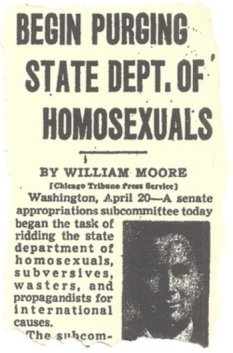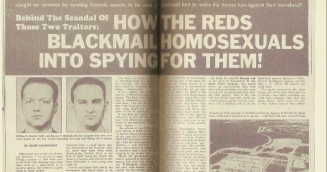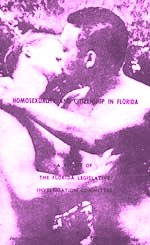Most Americans are aware of the Red Scare — the witch hunt for Communist agents in the US led by Senator Joseph McCarthy. Despite the infamy of that event, there was a notable queer element that often gets overlooked, despite lasting longer and impacting a greater number of government employees: the Lavender Scare. Gay men and lesbians were said to be communist sympathizers and dangerous security risks. Given that the 1947 Sex Perversion Elimination Program had already seen to legally labeling homosexuals as dangerously mentally ill, so these assertions fed into growing public unease. There was a national call to fire them from employment in the Federal government — which made it even more difficult for queer people to be out of the closet anywhere in the United States. Though the official Lavender Scare was focused on Federal government and armed forces employees and contractors, you can be sure that thousands more across the country lost their jobs simply because of the fear that McCarthy and his allies were stoking.
 In February, 1950 McCarthy announced that he had a list of Communists that worked for the government. Two names on that last were homosexuals who had been fired and then rehired. Senators Kenneth S. Wherry and Senator J. Lister Hill interrogated these two individuals — called “Case 14“and “Case 62“. I can’t find real names for those two, but they were dismissed from their positions — the first official victims of the Lavender Scare. A week later Deputy Undersecretary of State John Purefoy testified before the Senate Committee on Appropriations that the State Department had actually fired, and later hidden, 91 suspected homosexual employees they had flagged as security risks. In truth, the Senate Committee was not shocked to learn this, since they had essentially given the State Department leeway to purge homosexuals from employment in 1946. However, the testimony revealed this information to the public and granted legitimacy to all of McCarthy’s claims — strengthening public support for his Red Scare.
In February, 1950 McCarthy announced that he had a list of Communists that worked for the government. Two names on that last were homosexuals who had been fired and then rehired. Senators Kenneth S. Wherry and Senator J. Lister Hill interrogated these two individuals — called “Case 14“and “Case 62“. I can’t find real names for those two, but they were dismissed from their positions — the first official victims of the Lavender Scare. A week later Deputy Undersecretary of State John Purefoy testified before the Senate Committee on Appropriations that the State Department had actually fired, and later hidden, 91 suspected homosexual employees they had flagged as security risks. In truth, the Senate Committee was not shocked to learn this, since they had essentially given the State Department leeway to purge homosexuals from employment in 1946. However, the testimony revealed this information to the public and granted legitimacy to all of McCarthy’s claims — strengthening public support for his Red Scare.

On April 15, 1950, the Republican National Chair Guy George Gabrielson (a name that truly sounds fictional, but it isn’t) made the claim that “sexual perverts” who had infiltrated the government were “perhaps as dangerous as actual Communists.” He argued that homosexuals were susceptible to blackmail and therefore a great risk to national security. (Later investigations found that not a single person who lost their job during the Lavender Scare ever revealed classified information, and most never had access to any. In case there was any confusion, this was never actually about national security!)

In a somewhat ironic twist, McCarthy hired Roy Cohn — a closeted homosexual — to be the chief counsel of the Congressional subcommittee. (Cohn was also a terrible, terrible human being. We can’t all be winners, I suppose.) Working alongside J. Edgar Hoover, they fired multitudes of accused gay men and lesbians. They also used rumors of homosexual activity to coerce their opponents and to smear those they suspected of being communists.
In March of 1952, the Federal government fired 162 employees because they might have been gay. On April 27, 1953, President Dwight D. Eisenhower signed Executive Order 10450 which — among other effects — led to a ban on gays and lesbians working for the Federal government of the United States altogether and even more heightened drive to uncover homosexual infiltrators. Suspected homosexuals were interviewed and surveilled for signs of gender non-conformity — as were their roommates and friends. Investigators relied on “guilty by association” — anyone with ties to homosexuals must be one as well. People were given lie detector tests and grilled with questions about their personal sexual history. Police were asked to raid gay bars and homosexual meeting places, and then share their arrest records. Within its first year 425 suspected homosexuals were fired from the State Department alone. Over 5,000 Federal employees were fired because of suspicions that they were homosexuals. Every single one of them was not only lost their job, but was publicly outed as well. Many more were pressured into resigning.
 McCarthy effectively convinced the government and the media of a connection between homosexuality and Communism — calling them both “threats to the American way of life” and even blatantly telling reporters “if you want to be against McCarthy, boys, you’ve got to be either a Communist or a cocksucker.” He repeatedly referred to homosexuality as an invasion. The rhetoric caught on. Those who’d been removed from their jobs found it impossible to get hired anywhere else — a few resorted to suicide. Federal investigators later covered up most of those deaths.
McCarthy effectively convinced the government and the media of a connection between homosexuality and Communism — calling them both “threats to the American way of life” and even blatantly telling reporters “if you want to be against McCarthy, boys, you’ve got to be either a Communist or a cocksucker.” He repeatedly referred to homosexuality as an invasion. The rhetoric caught on. Those who’d been removed from their jobs found it impossible to get hired anywhere else — a few resorted to suicide. Federal investigators later covered up most of those deaths.
The effects of the investigations rapidly expanded out from just government work, leading to an untold number of homosexuals (and suspected homosexuals) being fired and denied employment from even ordinary, non-government jobs — even in Hollywood. Gay and lesbian bars were raided by police with an ever-increasing regularity. Even queer organizations like the Mattachine Society (which was founded partially in 1950 partly in response to the Lavender Scare) were forced to adapt by 1953, adopting specific policies that specified they were loyal to the United States and forcing out founder Harry Hays — who happened to actually be a gay Communist.
The discriminatory practices destroyed lives and families, even among the most powerful people in the country. After Lester “Buddy” Hunt Jr. was arrested for soliciting prostitution from a male undercover police officer, his father Senator Lester Hunt was blackmailed and attacked by his political opponents (which included McCarthy) — destroying his political career and tearing apart his family. On June 19, 1954, he sat down at his desk in his Senate office and shot himself in the head with a rifle.
It wasn’t until Frank Kameny was fired from the United States Army Maps Service that anyone sought to challenge these firings in court. He brought his case all the way up to the Supreme Court — making him the first person to argue in United States courtrooms that homosexuals were being treated as second class citizens. They decided against him in 1961. (This would be the beginning of Kameny’s profound influence over LGBTQ+ rights in the U.S. — but he would never hold another paying job for the rest of his life, and survived only on the generosity of his friends.) In 1969, the Supreme Court had realized the error of its ways and ruled differently in a similar case. Of course, that didn’t help Kameny much.
 Between 1947 and 1961, more Federal employees had been fired for being suspected of being homosexual than were fired for being suspected of being Communist. Records of the number of people who were fired as part of the Lavender Scare get more than a little fuzzy after that, but it was hardly over. Even after the end of McCarthy’s career in 1957, the tactics used in the Lavender Scare remained in effect for several more years. In fact, the Florida Legislative Investigation Committee (aka the Johns Committee after state senator Charley Eugene Johns) officially began using these same practices to drive the queer population out of state universities in 1958. They pursued students and professors for doing such suspiciously homosexual behaviors as wearing Bermuda shorts on campus. Professors were immediately removed from their positions for even being suspected on queerness, students were allowed to remain on campus only if they routinely visited their school’s medical facility for routine psychological treatments. In 1964 the Committee began printing pamphlets entitled Homosexuality and Citizenship in Florida — or colloquially known as the Purple Pamphlet. Because it included pictures of homosexual activity, it was immediately considered controversial and called “state-sponsored pornography” — ultimately leading to the dissolution of the Committee in 1965.
Between 1947 and 1961, more Federal employees had been fired for being suspected of being homosexual than were fired for being suspected of being Communist. Records of the number of people who were fired as part of the Lavender Scare get more than a little fuzzy after that, but it was hardly over. Even after the end of McCarthy’s career in 1957, the tactics used in the Lavender Scare remained in effect for several more years. In fact, the Florida Legislative Investigation Committee (aka the Johns Committee after state senator Charley Eugene Johns) officially began using these same practices to drive the queer population out of state universities in 1958. They pursued students and professors for doing such suspiciously homosexual behaviors as wearing Bermuda shorts on campus. Professors were immediately removed from their positions for even being suspected on queerness, students were allowed to remain on campus only if they routinely visited their school’s medical facility for routine psychological treatments. In 1964 the Committee began printing pamphlets entitled Homosexuality and Citizenship in Florida — or colloquially known as the Purple Pamphlet. Because it included pictures of homosexual activity, it was immediately considered controversial and called “state-sponsored pornography” — ultimately leading to the dissolution of the Committee in 1965.

Executive Order 10450 was struck down in court in 1973 but not formally repealed. Parts of it were undone by President Bill Clinton, through the “Don’t Ask, Don’t Tell” policy and Executive Order 13087 — the latter of which officially ended the FBI’s and NSA’s discriminatory hiring practices. The Executive Order was not truly repealed until 2017, when — in one of his last acts in office — President Barack Obama signed Executive Order 13764. At about the same time, outgoing Secretary of State John Kerry finally issued a formal apology on behalf of the State Department for the discrimination that occurred.
The long-lasting effects of the Lavender Scare drove the queer community of the U.S. deeper underground, turned public sentiment against the LGBT+ community for decades, and to this day continues to impact hiring policies, and public ideas about homosexuality, around the country. Congress is, even now, preparing to decide on whether or not to pass the Equality Act — which would, among other things, protect LGBTQ+ people from employment discrimination. I would say that almost seventy years after the beginning of the Lavender Scare, it’s about time.
One thought on “Lavender Scare”